
Illustrative Math Alignment: Grade 6 Unit 8
Data Sets and Distributions
Lesson 12: Using Mean and MAD to Make Comparisons
Use the following Media4Math resources with this Illustrative Math lesson.
| Thumbnail Image | Title | Body | Curriculum Nodes |
|---|---|---|---|

|
Math Example--Measures of Central Tendency--Mean: Example 37 | Math Example--Measures of Central Tendency--Mean: Example 37TopicMeasures of Central Tendency DescriptionThis example illustrates the calculation of the mean for a new set of numbers. The process involves summing all values and dividing by the count of numbers. This example is particularly instructive as it continues to reinforce the concept of finding a central value that represents the entire dataset, potentially dealing with a different range or distribution of numbers than previous examples. |
Data Analysis |

|
Math Example--Measures of Central Tendency--Mean: Example 38 | Math Example--Measures of Central Tendency--Mean: Example 38TopicMeasures of Central Tendency DescriptionThis example demonstrates the calculation of the mean for a set of numbers. The process involves summing all values and dividing by the count of numbers. This example is particularly instructive as it reinforces the concept of finding a central value that represents the entire dataset, potentially dealing with a different range or distribution of numbers than previous examples. |
Data Analysis |
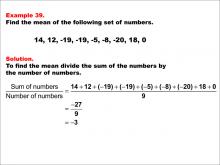
|
Math Example--Measures of Central Tendency--Mean: Example 39 | Math Example--Measures of Central Tendency--Mean: Example 39TopicMeasures of Central Tendency DescriptionThis example illustrates the calculation of the mean for a new set of numbers. The process involves summing all values and dividing by the count of numbers. This example is particularly instructive as it continues to reinforce the concept of finding a central value that represents the entire dataset, potentially dealing with a different range or distribution of numbers than previous examples. |
Data Analysis |
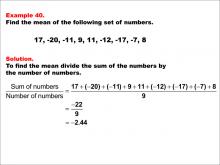
|
Math Example--Measures of Central Tendency--Mean: Example 40 | Math Example--Measures of Central Tendency--Mean: Example 40TopicMeasures of Central Tendency DescriptionThis example demonstrates the calculation of the mean for another set of numbers. The process involves summing all values and dividing by the count of numbers. This example is particularly instructive as it continues to reinforce the concept of finding a central value that represents the entire dataset, potentially dealing with a different range or distribution of numbers than previous examples. |
Data Analysis |
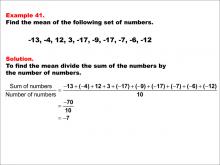
|
Math Example--Measures of Central Tendency--Mean: Example 41 | Math Example--Measures of Central Tendency--Mean: Example 41TopicMeasures of Central Tendency DescriptionThis example illustrates the calculation of the mean for a new set of numbers. The process involves summing all values and dividing by the count of numbers. This example is particularly instructive as it continues to reinforce the concept of finding a central value that represents the entire dataset, potentially dealing with a different range or distribution of numbers than previous examples. |
Data Analysis |
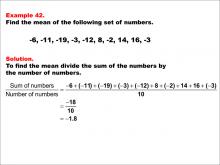
|
Math Example--Measures of Central Tendency--Mean: Example 42 | Math Example--Measures of Central Tendency--Mean: Example 42TopicMeasures of Central Tendency DescriptionThis example demonstrates the calculation of the mean for another set of numbers. The process involves summing all values and dividing by the count of numbers. This example is particularly instructive as it continues to reinforce the concept of finding a central value that represents the entire dataset, potentially dealing with a different range or distribution of numbers than previous examples. |
Data Analysis |
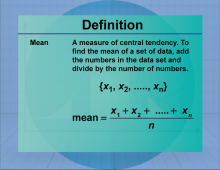
|
Definition--Measures of Central Tendency--Mean | MeanTopicStatistics DefinitionThe mean is a measure of central tendency that provides an average representation of a set of data. DescriptionThe Mean is an important concept in statistics, used to summarize data effectively. In real-world applications, the Mean helps to interpret data distributions and is widely used in areas such as economics, social sciences, and research. For example, if a data set consists of the values 2, 3, and 10, the mean is calculated as (2 + 3 + 10)/3 = 5. |
Data Analysis |
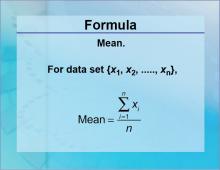
|
Formulas--Mean | Formulas--Mean
The formula for the Mean. This is part of a collection of math formulas. To see the complete collection of formulas, click on this link. Note: The download is a JPG file.Related ResourcesTo see resources related to this topic click on the Related Resources tab above. |
Data Analysis |

|
MATH EXAMPLES--The Mean | MATH EXAMPLES--The Mean
This set of tutorials provides 42 examples of calculating the mean. NOTE: The download is a PPT file. |
Data Analysis |

|
VIDEO: Ti-Nspire Mini-Tutorial, Video 70 | VIDEO: TI-Nspire Mini-Tutorial: Finding the Mean of a Data List
In this TI Nspire tutorial, the Spreadsheet and Calculator windows are used to find the mean of a data list. This video supports the TI-Nspire Clickpad and Touchpad. |
Data Analysis |